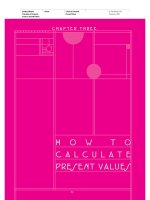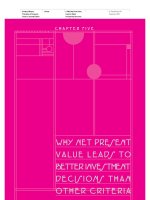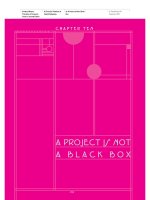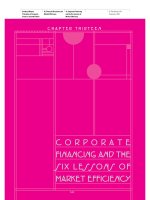Lecture Accounting principles (7th Edition): Chapter 25 – Weygandt, Kieso, Kimmel
Bạn đang xem bản rút gọn của tài liệu. Xem và tải ngay bản đầy đủ của tài liệu tại đây (2.92 MB, 56 trang )
Accounting Principles, 7th Edition
Weygandt • Kieso • Kimmel
Chapter 25
Budgetary Control and
Responsibility Accounting
Prepared by Naomi Karolinski
Monroe Community College
and
Marianne Bradford
Bryant College
John Wiley & Sons, Inc. © 2005
CHAPTER 25
Budgetary Control and
Responsibility Accounting
After studying this chapter, you should be able to:
1 Describe the concept of budgetary control.
2 Evaluate the usefulness of static budget reports.
3 Explain the development of flexible budgets and
the usefulness of flexible budget reports.
4 Describe the concept of responsibility
accounting.
5 Indicate the features of responsibility reports
for cost centers.
After studying this chapter, you should be able to:
6 Identify the content of responsibility
reports for profit centers.
7 Explain the basis and formula used in
evaluating performance in investment
centers.
Budgetary Control
STUDY OBJECTIVE 1
• Budget reports compare actual results with planned
objectives.
• Provides management with feedback on operations.
Budgetary Control
Budgetary Control
A formalized reporting system should :
•
Identify the name of the budget report:
–
•
such as the sales budget or the manufacturing
overhead budget
Frequency of the report
–
•
•
weekly or monthly
Purpose of the report
Recipient(s) of the report
Budgetary Control Reporting
System
The schedule above illustrates a partial budgetary control
system for a manufacturing company. Note the frequency of
reports and their emphasis on control
Static Budget Reports
STUDY OBJECTIVE 2
• Projection of budget data at one level of activity.
• Data for different levels of activity are ignored.
• Actual results are always compared with the
budget data at the activity level in the master
budget.
Budget and Actual Sales Data
To illustrate the role of a static budget in budgetary
control, we will use selected data for Hayes
Company prepared in Chapter 24.
Budget and actual sales data for the Kitchen-mate
product in the first and second quarters of 2005 are as
follows:
$1,000 $10,500 $11,500
Sales Budget Report:
First Quarter
The sales budget report for Hayes Company’s 1st quarter is
shown below.
$1,000 U
The report shows that sales are $1,000 under budget - an
unfavorable result. This difference is less that 1% of budgeted
sales ($1,000/$180,000 =.0056), we will assume that top
management of Hayes Company will view the difference as
immaterial and take no specific action.
Sales Budget Report:
Second Quarter
$10,500 U
The second quarter shows that sales were $10,500
below budget, which is 5% of budgeted sales
($10,500/$210,000). Top management may conclude
that the difference between budgeted and actual sales
in the second quarter merits investigation and will
begin by asking the sales manager the cause(s).
Uses and Limitations
A static budget evaluates a manager’s effectiveness
in controlling costs when:
• Actual level of activity closely approximates the master
budget activity level, and/or
• Behavior of the costs in response to changes in activity is
fixed.
A static budget is useful in controlling
costs when cost behavior is:
a. mixed.
b. fixed.
c. variable.
d. linear.
A static budget is useful in controlling
costs when cost behavior is:
a. mixed.
b. fixed.
c. variable.
d. linear.
Flexible Budgets
STUDY OBJECTIVE 3
• A flexible budget projects budget data for
various levels of activity.
• The flexible budget recognizes that the
budgetary process is more useful if it is
adaptable to changed operating conditions.
Static Overhead Budget
(Budget based on 10,000 units of production)
Barton Steel prepares the above static budget for manufacturing overhead
based on a production volume of 10,000 units of steel ingots.
Static Overhead Budget Report
If demand for steel
ingots has increased
and 12,000 units are
produced during the
year, rather than
10,000, the budget
report will show
very large variances.
This is because the
comparison is based
on budget data
based
on the original
activity level (10,000
steel ingots).
Variable
budget allowances
have increased with
production.
$ 45,000 U
52,000 U
35,000 U
0
0
0
$132,000
Variable Costs per Unit
/10,000 units $25
/10,000 units 26
/10,000 units 19
$70
Comparing actual variable costs with budgeted costs
is meaningless (due to different levels of activity),
variable per unit costs must be isolated, so the budget
can be adjusted. An analysis of the budget data for
these costs at 10,000 units produces the above
per unit results:
Illustration 25-9
Budgeted Variable Costs
(12,000 units)
$300,000
312,000
228,000
$840,000
The budgeted variable costs at 12,000
units, therefore, are shown above.
Because FIXED costs do not change in
total as activity changes, the budgeted
amounts for these costs remain the same.
Flexible Overhead Budget Report
This budget
report based
on the flexible
budget for
12,000 units
of production
shows that
the Forging
Department
is below
budgeta favorable
difference.
$ 5,000 F
0
3,000 F
8,000 F
0
0
0
0
Developing the Flexible Budget
• Identify the activity index and the relevant range of
activity.
• Identify the variable costs, and determine the
budgeted variable cost per unit of activity for each
cost.
• Identify the fixed costs, and determine the budgeted
amount for each cost.
• Prepare the budget for selected increments of
activity within the relevant range.
Flexible Budget -A Case Study
Master Budget Data
Fox Company wants to use a flexible budget for monthly
comparisons of actual and budgeted manufacturing
overhead costs. The master budget for the year ended
December 31, 2005 is prepared using 120,000 direct
labor hours and the following overhead costs.
STEP 1: Identify the activity index and the relevant range of activity:
The activity index is direct labor hours and management concludes
that the relevant range is 8,00012,000 direct labor hours.
Flexible Budget-A Case Study
Computation of variable costs per direct labor hour
STEP 2: Identify the variable costs and determine the budgeted variable
cost per unit of activity for each cost.
There are 3 variable costs and the per unit variable cost is found by
dividing each total budgeted cost by the direct labor hours used in
preparing the master budget (120,000 hours).
Flexible Budget
A Case Study
• Step 3: Identify the fixed costs and determine the
budgeted amount for each cost.
• There are three fixed costs and since Fox desires monthly
budget data, the budgeted amount is found by dividing
each annual budgeted cost by 12 ($180,000/12 =$15,000).
Flexible Budget - A Case Study
Flexible Monthly Overhead Budget
Step 4: Prepare the budget for selected increments of activity within
the relevant range.









